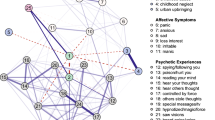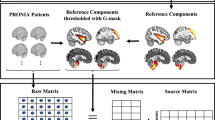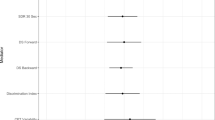Abstract
Genetic variation in AKT1 may be associated with sensitivity to the psychotomimetic effects of cannabis as well as with increased risk for psychotic disorder following cannabis use. Investigation of the effect of this interaction on relevant intermediate phenotypes for psychosis, such as cognition, may help to clarify the underlying mechanism. Thus, verbal memory (visually presented Word Learning Task), sustained attention (Continuous Performance Test, CPT), AKT1 rs2494732 genotype, and cannabis use were examined in a large cohort of patients with psychotic disorder. No evidence was found for AKT1 × cannabis interaction on verbal memory. Cannabis use preceding onset of psychotic disorder did interact significantly with AKT1 rs2494732 genotype to affect CPT reaction time (β=8.0, SE 3.9, p=0.037) and CPT accuracy (β=−1.2, SE 0.4, p=0.003). Cannabis-using patients with the a priori vulnerability C/C genotype were slower and less accurate on the CPT, whereas cannabis-using patients with the T/T genotype had similar or better performance than non-using patients with psychotic disorder. The interaction was also apparent in patients with psychotic disorder who had not used cannabis in the 12 months preceding assessment, but was absent in the unaffected siblings of these patients and in healthy controls. In conclusion, cannabis use before onset of psychosis may have long-lasting effects on measures of sustained attention, even in the absence of current use, contingent on AKT1 rs2494732 genotype. The results suggest that long-term changes in cognition may mediate the risk-increasing effect of the AKT1 × cannabis interaction on psychotic disorder.
Similar content being viewed by others
Log in or create a free account to read this content
Gain free access to this article, as well as selected content from this journal and more on nature.com
or
References
American Psychiatric Association (ed) (2000). Diagnostic and Statistical Manual of Mental Disorders, 4th edn. Text revision. American Psychiatric Association: Washington, DC.
Andreasen NC, Flaum M, Arndt S (1992). The Comprehensive Assessment of Symptoms and History (CASH). An instrument for assessing diagnosis and psychopathology. Arch Gen Psychiatry 49: 615–623.
Arguello PA, Gogos JA (2008). A signaling pathway AKTing up in schizophrenia. J Clin Invest 118: 2018–2021.
Bajestan SN, Sabouri AH, Nakamura M, Takashima H, Keikhaee MR, Behdani F et al (2006). Association of AKT1 haplotype with the risk of schizophrenia in Iranian population. Am J Med Genet B Neuropsychiatr Genet 141B: 383–386.
Blyler CR, Gold JM, Iannone VN, Buchanan RW (2000). Short form of the WAIS-III for use with patients with schizophrenia. Schizophr Res 46: 209–215.
Bolla KI, Brown K, Eldreth D, Tate K, Cadet JL (2002). Dose-related neurocognitive effects of marijuana use. Neurology 59: 1337–1343.
Cardno AG, Rijsdijk FV, Sham PC, Murray RM, McGuffin P (2002). A twin study of genetic relationships between psychotic symptoms. Am J Psychiatry 159: 539–545.
Caspi A, Moffitt TE, Cannon M, McClay J, Murray R, Harrington H et al (2005). Moderation of the effect of adolescent-onset cannabis use on adult psychosis by a functional polymorphism in the catechol-O-methyltransferase gene: longitudinal evidence of a gene X environment interaction. Biol Psychiatry 57: 1117–1127.
Cordell HJ, Clayton DG (2005). Genetic association studies. Lancet 366: 1121–1131.
D’Souza DC, Abi-Saab WM, Madonick S, Forselius-Bielen K, Doersch A, Braley G et al (2005). Delta-9-tetrahydrocannabinol effects in schizophrenia: implications for cognition, psychosis, and addiction. Biol Psychiatry 57: 594–608.
D’Souza DC, Perry E, MacDougall L, Ammerman Y, Cooper T, Wu YT et al (2004). The psychotomimetic effects of intravenous delta-9-tetrahydrocannabinol in healthy individuals: implications for psychosis. Neuropsychopharmacology 29: 1558–1572.
Emamian ES, Hall D, Birnbaum MJ, Karayiorgou M, Gogos JA (2004). Convergent evidence for impaired AKT1-GSK3beta signaling in schizophrenia. Nat Genet 36: 131–137.
Franke TF (2008). PI3K/Akt: getting it right matters. Oncogene 27: 6473–6488.
Freyberg Z, Ferrando SJ, Javitch JA (2010). Roles of the Akt/GSK-3 and Wnt signaling pathways in schizophrenia and antipsychotic drug action. Am J Psychiatry 167: 388–396.
Fried PA, Watkinson B, Gray R (2005). Neurocognitive consequences of marihuana--a comparison with pre-drug performance. Neurotoxicol Teratol 27: 231–239.
Genetic Risk and Outcome of Psychosis (GROUP) Investigators (2011). Evidence that familial liability for psychosis is expressed as differential sensitivity to cannabis: an analysis of patient-sibling and sibling-control pairs. Arch Gen Psychiatry 68: 138–147.
Habets P, Marcelis M, Gronenschild E, Drukker M, Van Os J (2011). Reduced cortical thickness as an outcome of differential sensitivity to environmental risks in schizophrenia. Biol Psychiatry 69: 487–494.
Heinrichs RW, Zakzanis KK (1998). Neurocognitive deficit in schizophrenia: a quantitative review of the evidence. Neuropsychology 12: 426–445.
Henquet C, Murray R, Linszen D, van Os J (2005). The environment and schizophrenia: the role of cannabis use. Schizophr Bull 31: 608–612.
Henquet C, Rosa A, Krabbendam L, Papiol S, Fananas L, Drukker M et al (2006). An experimental study of catechol-o-methyltransferase Val158Met moderation of delta-9-tetrahydrocannabinol-induced effects on psychosis and cognition. Neuropsychopharmacology 31: 2748–2757.
Ide M, Ohnishi T, Murayama M, Matsumoto I, Yamada K, Iwayama Y et al (2006). Failure to support a genetic contribution of AKT1 polymorphisms and altered AKT signaling in schizophrenia. J Neurochem 99: 277–287.
Ikeda M, Iwata N, Suzuki T, Kitajima T, Yamanouchi Y, Kinoshita Y et al (2004). Association of AKT1 with schizophrenia confirmed in a Japanese population. Biol Psychiatry 56: 698–700.
Jockers-Scherubl MC, Wolf T, Radzei N, Schlattmann P, Rentzsch J, Gomez-Carillo de Castro A et al (2007). Cannabis induces different cognitive changes in schizophrenic patients and in healthy controls. Prog Neuropsychopharmacol Biol Psychiatry 31: 1054–1063.
Liu YC, Huang CL, Wu PL, Chang YC, Huang CH, Lane HY (2009). Lack of association between AKT1 variances versus clinical manifestations and social function in patients with schizophrenia. J Psychopharmacol 23: 937–943.
Meijer J, Simons C, Quee PJ, Verweij K Genetic Risk and Outcome of Psychosis (GROUP) Investigations (submitted) Cognitive alterations in patients with non-affective psychotic disorder and their unaffected siblings and parents.
Molina-Holgado F, Pinteaux E, Heenan L, Moore JD, Rothwell NJ, Gibson RM (2005). Neuroprotective effects of the synthetic cannabinoid HU-210 in primary cortical neurons are mediated by phosphatidylinositol 3-kinase/AKT signaling. Mol Cell Neurosci 28: 189–194.
Moore TH, Zammit S, Lingford-Hughes A, Barnes TR, Jones PB, Burke M et al (2007). Cannabis use and risk of psychotic or affective mental health outcomes: a systematic review. Lancet 370: 319–328.
Murray RM, Morrison PD, Henquet C, Di Forti M (2007). Cannabis, the mind and society: the hash realities. Nat Rev Neurosci 8: 885–895.
Musshoff F, Madea B (2006). Review of biologic matrices (urine, blood, hair) as indicators of recent or ongoing cannabis use. Ther Drug Monit 28: 155–163.
NIMH Genetics Initiative (1992). Family Interview for Genetic Studies (FIGS). National Institute of Mental Health: Rockville, MD.
Norton N, Williams HJ, Dwyer S, Carroll L, Peirce T, Moskvina V et al (2007). Association analysis of AKT1 and schizophrenia in a UK case control sample. Schizophr Res 93: 58–65.
Nuechterlein KHR, Dawson ME (1984). Information processing and attentional functioning in the developmental course of schizophrenics disorders. Schizophr Bull 10: 160–203.
O’Tuathaigh CM, Hryniewiecka M, Behan A, Tighe O, Coughlan C, Desbonnet L et al (2010). Chronic adolescent exposure to delta-9-tetrahydrocannabinol in COMT mutant mice: impact on psychosis-related and other phenotypes. Neuropsychopharmacology 35: 2262–2273.
Ozaita A, Puighermanal E, Maldonado R (2007). Regulation of PI3K/Akt/GSK-3 pathway by cannabinoids in the brain. J Neurochem 102: 1105–1114.
Pope Jr HG., Gruber AJ, Hudson JI, Huestis MA, Yurgelun-Todd D (2002). Cognitive measures in long-term cannabis users. J Clin Pharmacol 42: 41S–47S.
Pope Jr HG., Yurgelun-Todd D (1996). The residual cognitive effects of heavy marijuana use in college students. JAMA 275: 521–527.
Rabin RA, Zakzanis KK, George TP (2011). The effects of cannabis use on neurocognition in schizophrenia: a meta-analysis. Schizophr Res 128: 111–116.
Rais M, Cahn W, van Haren NE, Schnack HG, Caspers E, Hulshoff Pol HE et al (2008). Excessive brain volume loss over time in cannabis-using first-episode schizophrenia patients. Am J Psychiatry 165: 490–496.
Rais M, van Haren NE, Cahn W, Schnack HG, Lepage C, Collins L et al (2010). Cannabis use and progressive cortical thickness loss in areas rich in CB1 receptors during the first five years of schizophrenia. Eur Neuropsychopharmacol 20: 855–865.
Sanchez MG, Ruiz-Llorente L, Sanchez AM, Diaz-Laviada I (2003). Activation of phosphoinositide 3-kinase/PKB pathway by CB(1) and CB(2) cannabinoid receptors expressed in prostate PC-3 cells. Involvement in Raf-1 stimulation and NGF induction. Cell Signal 15: 851–859.
Schwab SG, Hoefgen B, Hanses C, Hassenbach MB, Albus M, Lerer B et al (2005). Further evidence for association of variants in the AKT1 gene with schizophrenia in a sample of European sib-pair families. Biol Psychiatry 58: 446–450.
Seidman LJ, Giuliano AJ, Meyer EC, Addington J, Cadenhead KS, Cannon TD et al (2010). Neuropsychology of the prodrome to psychosis in the NAPLS consortium: relationship to family history and conversion to psychosis. Arch Gen Psychiatry 67: 578–588.
Solowij N, Michie PT (2007). Cannabis and cognitive dysfunction: parallels with endophenotypes of schizophrenia? J Psychiatry Neurosci 32: 30–52.
StataCorp (2009) Stata/SE statistical software, release 11. StataCorp LP, College Station, TX.
Sullivan PF (2007). Spurious genetic associations. Biol Psychiatry 61: 1121–1126.
Tan HY, Nicodemus KK, Chen Q, Li Z, Brooke JK, Honea R et al (2008). Genetic variation in AKT1 is linked to dopamine-associated prefrontal cortical structure and function in humans. J Clin Invest 118: 2200–2208.
Thiselton DL, Vladimirov VI, Kuo PH, McClay J, Wormley B, Fanous A et al (2008). AKT1 is associated with schizophrenia across multiple symptom dimensions in the Irish study of high density schizophrenia families. Biol Psychiatry 63: 449–457.
Van Der Elst W, Van Boxtel MPJ, Van Breukelen GJP, Jolles J (2005). Rey′s Verbal Learning Test: normative data for 1855 healthy participants aged 24-81 years and the influence of age, sex, education, and mode of presentation. J Int Neuropsycholog Soc 11: 290–302.
Van Oel CJ, Sitskoorn MM, Cremer MP, Kahn RS (2002). School performance as a premorbid marker for schizophrenia: a twin study. Schizophr Bull 28: 401–414.
van Winkel R, Esquivel G, Kenis G, Wichers M, Collip D, Peerbooms O et al (2010). Genome-wide findings in schizophrenia and the role of gene-environment interplay. CNS Neurosci Ther 16: e185–e192.
van Winkel R and Genetic Risk and Outcome of Psychosis (GROUP) Investigators (2011). Family-based analysis of genetic variation underlying psychosis-inducing effects of cannabis: sibling analysis and proband follow-up. Arch Gen Psychiatry 68: 148–157.
van Winkel R, Myin-Germeys I, De Hert M, Delespaul P, Peuskens J, van Os J (2007). The association between cognition and functional outcome in first-episode patients with schizophrenia: mystery resolved? Acta Psychiatr Scand 116: 119–124.
van Winkel R, Myin-Germeys I, Delespaul P, Peuskens J, De Hert M, van Os J (2006). Premorbid IQ as a predictor for the course of IQ in first onset patients with schizophrenia: a 10-year follow-up study. Schizophr Res 88: 47–54.
Wing JK, Babor T, Brugha T, Burke J, Cooper JE, Giel R et al (1990). SCAN schedules for clinical assessment in neuropsychiatry. Arch Gen Psychiatry 47: 589–593.
Winterer G, Weinberger DR (2004). Genes, dopamine and cortical signal-to-noise ratio in schizophrenia. Trends Neurosci 27: 683–690.
Yücel M, Bora E, Lubman DI, Solowij N, Brewer WJ, Cotton SM et al (2010). The impact of cannabis use on cognitive functioning in patients with schizophrenia: a meta-analysis of existing findings and new data in a first-episode sample. Schizophr Bull; doi:10.1093/schbul/sbq1079.
Yücel M, Solowij N, Respondek C, Whittle S, Fornito A, Pantelis C et al (2008). Regional brain abnormalities associated with long-term heavy cannabis use. Arch Gen Psychiatry 65: 694–701.
Acknowledgements
The infrastructure for the GROUP study is funded by the Geestkracht program of the Dutch Health Research Council (ZON-MW, Grant number 10-000-1002) and matching funds from participating universities and mental health care organizations (Site Amsterdam: Academic Psychiatric Centre AMC, Ingeest, Arkin, Dijk en Duin, Rivierduinen, Erasmus MC, GGZ Noord Holland Noord; Site Utrecht: University Medical Centre Utrecht, Altrecht, Symfora, Meerkanten, Riagg Amersfoort, Delta; Site Groningen: University Medical Center Groningen, Lentis, GGZ Friesland, GGZ Drenthe, Dimence, Mediant, GGZ De Grote Rivieren and Parnassia Bavo Groep; Site Maastricht: Maastricht University Medical Center, GGZ Eindhoven, GGZ Midden-Brabant, GGZ Oost-Brabant, GGZ Noord- Midden Limburg, Mondriaan Zorggroep, Prins Clauscentrum Sittard, RIAGG Roermond, Universitair Centrum Sint-Jozef Kortenberg, CAPRI University of Antwerp, PC Ziekeren Sint-Truiden, PZ Sancta Maria Sint-Truiden, GGZ Overpelt, OPZ Rekem). We are grateful for the generosity of time and effort by the families who make this GROUP project possible. The research leading to these results has received funding from the European Community′s Seventh Framework Program under grant agreement No. HEALTH-F2-2009-241909 (Project EU-GEI). The analyses were supported by unrestricted grants from Jansen-Cilag, Eli Lilly and Company, Astra-Zeneca, and Lundbeck.
Author information
Authors and Affiliations
Consortia
Corresponding author
Ethics declarations
Competing interests
Dr van Winkel has been an unrestricted grant holder with AstraZeneca and Eli Lilly. Dr van Beveren has been an unrestricted grant holder with PsyNova Neurotech Cambridge. Professor De Haan has received research funding from Eli Lilly and honoraria from Eli Lilly, Janssen-Cilag, BMS, and AstraZeneca. Professor van Os is/has been an unrestricted research grant holder with, or has received financial compensation as an independent symposium speaker from Eli Lilly, BMS, Lundbeck, Organon, Janssen-Cilag, GSK, AstraZeneca, Pfizer, and Servier. Dr Cahn is/has been an unrestricted research grant holder with, or has received financial compensation as an independent symposium speaker or as a consultant from Eli Lilly, BMS, Lundbeck, Sanofi-Aventis, Janssen-Cilag, AstraZeneca, and Schering-Plough. Professor Myin-Germeys has received financial compensation as an independent symposium speaker from BMS and Janssen-Cilag. Professor Kahn is/has been an unrestricted research grant holder with, or has received financial compensation as an independent symposium speaker or as a consultant from AstraZeneca, Eli Lilly, Janssen-Cilag, Otsuka, Sinovion, Roche, and Envivo. All other authors declare no conflict of interest.
Additional information
GROUP investigators: René S Kahn1, Don H Linszen2, Jim van Os3,4, Durk Wiersma5, Richard Bruggeman5, Wiepke Cahn1, Lieuwe de Haan2, Lydia Krabbendam3, Inez Myin-Germeys3. 1Department of Psychiatry, University Medical Center Utrecht, Rudolf Magnus Institute of Neuroscience, The Netherlands; 2Department of Psychiatry, Academic Medical Centre University of Amsterdam, Amsterdam, The Netherlands; 3Department of Psychiatry and Psychology, School of Mental Health and Neuroscience, European Graduate School of Neuroscience (EURON), South Limburg Mental Health Research and Teaching Network (SEARCH), Maastricht University Medical Centre, Maastricht, The Netherlands; 4Department of Psychosis Studies, King's College, King's Health Partners, Institute of Psychiatry, De Crespigny Park, Denmark Hill, London, UK; 5Department of Psychiatry, University Medical Center Groningen, University of Groningen, The Netherlands.
PowerPoint slides
Rights and permissions
About this article
Cite this article
van Winkel, R., van Beveren, N., Simons, C. et al. AKT1 Moderation of Cannabis-Induced Cognitive Alterations in Psychotic Disorder. Neuropsychopharmacol 36, 2529–2537 (2011). https://doi.org/10.1038/npp.2011.141
Received:
Revised:
Accepted:
Published:
Issue date:
DOI: https://doi.org/10.1038/npp.2011.141
Keywords
This article is cited by
-
Childhood traumatic events and the dopaminergic theory of psychosis: A mini-review of studies investigating gene – environment interactions
Current Psychology (2023)
-
Network Biology Approaches to Uncover Therapeutic Targets Associated with Molecular Signaling Pathways from circRNA in Postoperative Cognitive Dysfunction Pathogenesis
Journal of Molecular Neuroscience (2022)
-
Pharmacogenetic-guided cannabis usage in the community pharmacy: evaluation of a pilot program
Journal of Cannabis Research (2020)
-
Non-Genetic Factors in Schizophrenia
Current Psychiatry Reports (2019)
-
Does Cannabis Composition Matter? Differential Effects of Delta-9-tetrahydrocannabinol and Cannabidiol on Human Cognition
Current Addiction Reports (2017)



